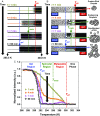A stepwise mechanism for aqueous two-phase system formation in concentrated antibody solutions
- PMID: 31337677
- PMCID: PMC6690023
- DOI: 10.1073/pnas.1900886116
A stepwise mechanism for aqueous two-phase system formation in concentrated antibody solutions
Abstract
Aqueous two-phase system (ATPS) formation is the macroscopic completion of liquid-liquid phase separation (LLPS), a process by which aqueous solutions demix into 2 distinct phases. We report the temperature-dependent kinetics of ATPS formation for solutions containing a monoclonal antibody and polyethylene glycol. Measurements are made by capturing dark-field images of protein-rich droplet suspensions as a function of time along a linear temperature gradient. The rate constants for ATPS formation fall into 3 kinetically distinct categories that are directly visualized along the temperature gradient. In the metastable region, just below the phase separation temperature, Tph , ATPS formation is slow and has a large negative apparent activation energy. By contrast, ATPS formation proceeds more rapidly in the spinodal region, below the metastable temperature, Tmeta , and a small positive apparent activation energy is observed. These region-specific apparent activation energies suggest that ATPS formation involves 2 steps with opposite temperature dependencies. Droplet growth is the first step, which accelerates with decreasing temperature as the solution becomes increasingly supersaturated. The second step, however, involves droplet coalescence and is proportional to temperature. It becomes the rate-limiting step in the spinodal region. At even colder temperatures, below a gelation temperature, Tgel , the proteins assemble into a kinetically trapped gel state that arrests ATPS formation. The kinetics of ATPS formation near Tgel is associated with a remarkably fragile solid-like gel structure, which can form below either the metastable or the spinodal region of the phase diagram.
Keywords: gelation; liquid–liquid phase separation; monoclonal antibody; temperature gradient microfluidics; upper critical solution temperature.
Conflict of interest statement
The authors declare no conflict of interest.
Figures







References
-
- Asherie N., Protein crystallization and phase diagrams. Methods 34, 266–272 (2004). - PubMed
-
- Trilisky E., Gillespie R., Osslund T. D., Vunnum S., Crystallization and liquid-liquid phase separation of monoclonal antibodies and fc-fusion proteins: Screening results. Biotechnol. Prog. 27, 1054–1067 (2011). - PubMed
-
- Mason B. D., Zhang L., Remmele R. L. Jr, Zhang J., Opalescence of an IgG2 monoclonal antibody solution as it relates to liquid-liquid phase separation. J. Pharm. Sci. 100, 4587–4596 (2011). - PubMed
Publication types
MeSH terms
Substances
LinkOut - more resources
Full Text Sources

